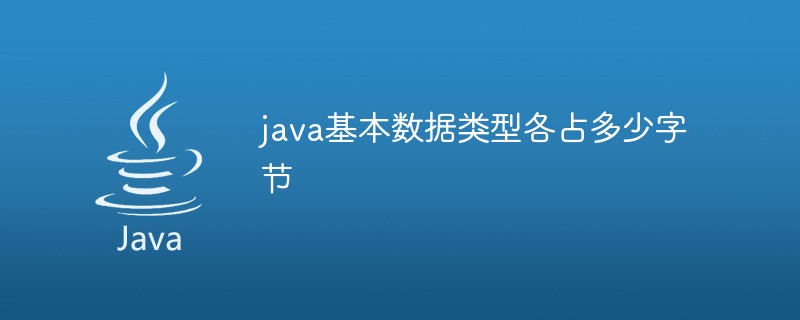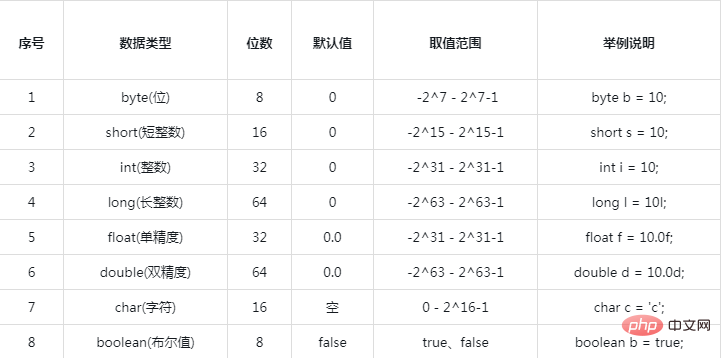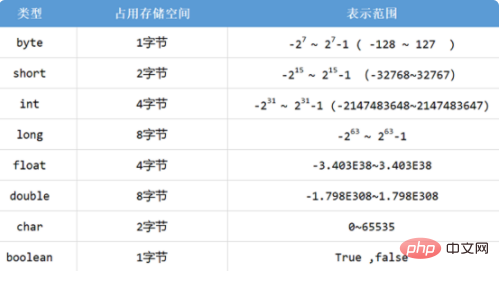How many bytes do each of Java's basic data types occupy?
Java has a total of 8 basic data types: 1. Int occupies 4 bytes, and the value range is "-2147483648~2147483647"; 2. Short occupies 2 bytes, and the value range is "-32768~ 32767"; 3. long occupies 8 bytes; 4. byte occupies 1 byte, and the value range is "-128~127"; 5. float is a single floating point type, occupies 4 bytes; 6. double is double float Point type, occupies 8 bytes; 7, char occupies 2 bytes; 8, boolean occupies 1 byte.

The operating environment of this tutorial: windows7 system, java8 version, DELL G3 computer.
About Java’s 8 basic data types, their names, digits, default values, value ranges and examples are shown in the following table:

Integer type
Among them, byte, short, int, and long all represent integers, but their value ranges are different
The value range of byte is -128~127, occupying 1 byte (-2 to the 7th power to the 7th power of 2 -1)
The value range of short is -32768~32767, occupying 2 bytes (-2 to the 15th power to 2 to the 15th power -1)
int The value range is (-2147483648~2147483647), occupying 4 bytes (-2 to the 31st power to 2-1). The value range of
long is (-9223372036854774808~9223372036854774807), occupying 8 bytes (-2 to the 63rd power to 2 to the 63rd power -1).
You can see that the value range of byte and short is relatively small, while the value range of long is too large and takes up a lot of space. Basically int can meet our daily calculations. , and int is also the most commonly used integer type.
Under normal circumstances, if an integer number such as 35 appears in JAVA, then this number is of int type. If we want it to be of byte type, we can add a capital B after the data: 35B , indicating that it is of byte type.
Similarly, 35S represents short type, and 35L represents long type. If it represents int, we can add nothing, but if we want to represent long type, we must add "L" after the data.
Floating point type
-
float, 4 bytes (, -3.4e 38 ~ 3.4e 38, 0.0f, Float
The float type value has a suffix F (for example: 3.14F)
-
double, 8 bytes, -1.7e 308 ~ 1.7 e 308, 0, Double
Floating point value without suffix F (for example: 3.14) defaults to double
The double type has a larger storage range and precision than the float type Higher, so usually floating-point data is of double type without declaration. If you want to indicate that a data is of float type, you can add "F" after the data.
Float Point type data is not completely accurate, so sometimes the last few decimal places may fluctuate during calculation. This is normal.
Character type
The data type used to store characters, occupies 2 bytes, uses unicode encoding, and its first 128 bytes of encoding are compatible with ASCII
The storage range of characters is \u0000~\uFFFF, in the definition When using character data, be careful to add ' '. For example, '1' means the character '1' instead of the value 1.
char c = ' 1 ';
Let's try to output c and see, System.out.println(c); the result It is 1, and if we output it like this System.out.println(c 0);
the result becomes 49.

Boolean
boolean, 1 byte, true false, FALSE, Boolean
For more related programming knowledge, please visit: Programming Learning Website!!
The above is the detailed content of How many bytes do each of Java's basic data types occupy?. For more information, please follow other related articles on the PHP Chinese website!

Hot AI Tools

Undresser.AI Undress
AI-powered app for creating realistic nude photos

AI Clothes Remover
Online AI tool for removing clothes from photos.

Undress AI Tool
Undress images for free

Clothoff.io
AI clothes remover

Video Face Swap
Swap faces in any video effortlessly with our completely free AI face swap tool!

Hot Article

Hot Tools

Notepad++7.3.1
Easy-to-use and free code editor

SublimeText3 Chinese version
Chinese version, very easy to use

Zend Studio 13.0.1
Powerful PHP integrated development environment

Dreamweaver CS6
Visual web development tools

SublimeText3 Mac version
God-level code editing software (SublimeText3)

Hot Topics
 Java Spring Interview Questions
Aug 30, 2024 pm 04:29 PM
Java Spring Interview Questions
Aug 30, 2024 pm 04:29 PM
In this article, we have kept the most asked Java Spring Interview Questions with their detailed answers. So that you can crack the interview.
 Break or return from Java 8 stream forEach?
Feb 07, 2025 pm 12:09 PM
Break or return from Java 8 stream forEach?
Feb 07, 2025 pm 12:09 PM
Java 8 introduces the Stream API, providing a powerful and expressive way to process data collections. However, a common question when using Stream is: How to break or return from a forEach operation? Traditional loops allow for early interruption or return, but Stream's forEach method does not directly support this method. This article will explain the reasons and explore alternative methods for implementing premature termination in Stream processing systems. Further reading: Java Stream API improvements Understand Stream forEach The forEach method is a terminal operation that performs one operation on each element in the Stream. Its design intention is
 PHP: A Key Language for Web Development
Apr 13, 2025 am 12:08 AM
PHP: A Key Language for Web Development
Apr 13, 2025 am 12:08 AM
PHP is a scripting language widely used on the server side, especially suitable for web development. 1.PHP can embed HTML, process HTTP requests and responses, and supports a variety of databases. 2.PHP is used to generate dynamic web content, process form data, access databases, etc., with strong community support and open source resources. 3. PHP is an interpreted language, and the execution process includes lexical analysis, grammatical analysis, compilation and execution. 4.PHP can be combined with MySQL for advanced applications such as user registration systems. 5. When debugging PHP, you can use functions such as error_reporting() and var_dump(). 6. Optimize PHP code to use caching mechanisms, optimize database queries and use built-in functions. 7
 PHP vs. Python: Understanding the Differences
Apr 11, 2025 am 12:15 AM
PHP vs. Python: Understanding the Differences
Apr 11, 2025 am 12:15 AM
PHP and Python each have their own advantages, and the choice should be based on project requirements. 1.PHP is suitable for web development, with simple syntax and high execution efficiency. 2. Python is suitable for data science and machine learning, with concise syntax and rich libraries.
 Java Program to Find the Volume of Capsule
Feb 07, 2025 am 11:37 AM
Java Program to Find the Volume of Capsule
Feb 07, 2025 am 11:37 AM
Capsules are three-dimensional geometric figures, composed of a cylinder and a hemisphere at both ends. The volume of the capsule can be calculated by adding the volume of the cylinder and the volume of the hemisphere at both ends. This tutorial will discuss how to calculate the volume of a given capsule in Java using different methods. Capsule volume formula The formula for capsule volume is as follows: Capsule volume = Cylindrical volume Volume Two hemisphere volume in, r: The radius of the hemisphere. h: The height of the cylinder (excluding the hemisphere). Example 1 enter Radius = 5 units Height = 10 units Output Volume = 1570.8 cubic units explain Calculate volume using formula: Volume = π × r2 × h (4
 PHP vs. Python: Core Features and Functionality
Apr 13, 2025 am 12:16 AM
PHP vs. Python: Core Features and Functionality
Apr 13, 2025 am 12:16 AM
PHP and Python each have their own advantages and are suitable for different scenarios. 1.PHP is suitable for web development and provides built-in web servers and rich function libraries. 2. Python is suitable for data science and machine learning, with concise syntax and a powerful standard library. When choosing, it should be decided based on project requirements.
 PHP vs. Other Languages: A Comparison
Apr 13, 2025 am 12:19 AM
PHP vs. Other Languages: A Comparison
Apr 13, 2025 am 12:19 AM
PHP is suitable for web development, especially in rapid development and processing dynamic content, but is not good at data science and enterprise-level applications. Compared with Python, PHP has more advantages in web development, but is not as good as Python in the field of data science; compared with Java, PHP performs worse in enterprise-level applications, but is more flexible in web development; compared with JavaScript, PHP is more concise in back-end development, but is not as good as JavaScript in front-end development.
 Create the Future: Java Programming for Absolute Beginners
Oct 13, 2024 pm 01:32 PM
Create the Future: Java Programming for Absolute Beginners
Oct 13, 2024 pm 01:32 PM
Java is a popular programming language that can be learned by both beginners and experienced developers. This tutorial starts with basic concepts and progresses through advanced topics. After installing the Java Development Kit, you can practice programming by creating a simple "Hello, World!" program. After you understand the code, use the command prompt to compile and run the program, and "Hello, World!" will be output on the console. Learning Java starts your programming journey, and as your mastery deepens, you can create more complex applications.






